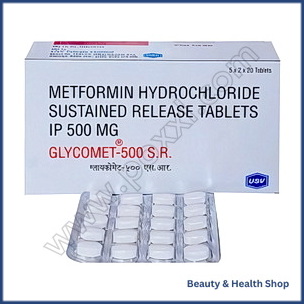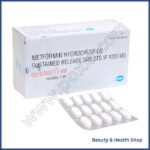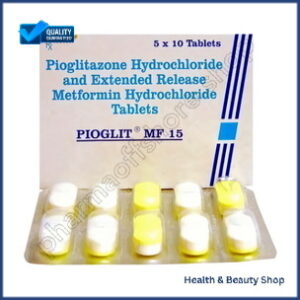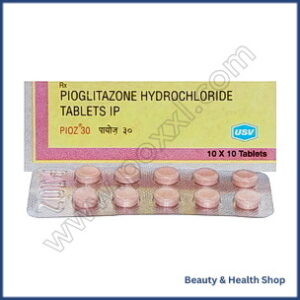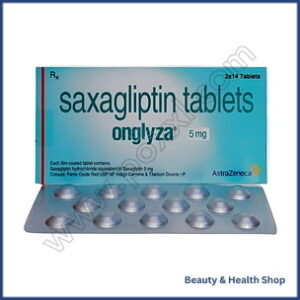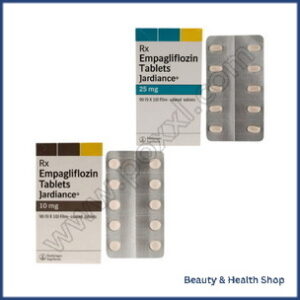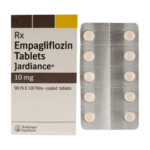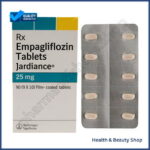ADDICTION
ALCOHOL DEPENDENCE
QUIT SMOKING
ALLERGY
ANTI FUNGAL
FUNGAL INFECTION
FUNGAL NAIL INFECTIONS
ANTI-REJECTION DRUGS
ANTI WORM
ANTIBIOTIC
BACTERIAL INFECTIONS
ARTHRITIS
GOUT
OSTEOARTHRITIS
RHEUMATOID ARTHRITIS
BLOOD
LOW PLATELET COUNT
THROMBOPHLEBITIS
VARICOSE VEINS
COLON
ANAL FISSURE
PILES
ULCERATIVE COLITIS
DIABETES CARE
DIABETES INSIPIDUS
DIABETES TYPE
DIABETIC FOOT ULCERS
GLUCOSE MONITOR
EYES/EAR CARE
DRY EYES
EYE CARE
EYE EXAMINATION
EYE INFECTION
EYE LASHES
EYE PAIN
GLAUCOMA
OCULAR HYPERTENSION
UVEITIS
FEVER CARE
MALARIA
RHEUMATIC FEVER
TYPHOID FEVER
GASTROINTESTINAL
ACIDITY
CONSTIPATION
CROHN'S DISEASE
DIARRHOEA
GALLBLADDER STONES
INTESTINAL ULCERS
IRRITABLE BOWEL SYNDROME
MOTION SICKNESS
NAUSEA
Glycomet (Metformin)
Glycomet 250 mg (Metformin)
Glycomet 500 mg (Metformin)
Glycomet 1000 mg (Metformin)
| Active Ingredient (Generic Name): | Metformin |
|---|---|
| Indication: | Type 2 diabetes |
| Manufacturer | USV Pvt Ltd |
| Packaging: | 15 tablets in one strip, 10 tablets in one strip |
From: $74.00
Glycomet, or Metformin, is commonly prescribed for type 2 diabetes. It falls under the biguanides drug class, reducing liver sugar production, enhancing muscle cell insulin sensitivity, and lowering blood sugar levels. To use effectively, follow dosing instructions, take with meals, and do not crush tablets. Glycomet is also used for PCOS, weight loss aid, and under study for cancer and neuroprotective benefits. Precautions include checking for drug interactions and monitoring side effects. Maintain a balanced diet, limit sugary foods, and watch for side effects like muscle pain. Remember to store properly, adhere to dosage, and consult healthcare providers for concerns.
Why is this medication prescribed?
If you have type 2 diabetes, your doctor may prescribe Glycomet, also known as Metformin, to help control your blood sugar levels.
Metformin is a medication that belongs to a class of drugs called biguanides, which work by decreasing the amount of sugar produced by the liver and increasing the sensitivity of muscle cells to insulin. By doing so, Metformin helps lower blood sugar levels in your body, making it easier for your cells to utilize sugar effectively.
This medication is commonly prescribed as a first-line treatment for type 2 diabetes, either alone or in combination with other antidiabetic drugs.
Apart from managing blood sugar levels, Metformin has also been associated with potential benefits such as weight loss and improved lipid profiles.
It’s important to follow your healthcare provider’s instructions carefully when taking Metformin to guarantee proper control of your diabetes and reduce the risk of complications associated with high blood sugar levels.
How should this medicine be used?
To use Glycomet (Metformin) effectively, follow the dosing instructions provided by your healthcare provider. Typically, this medication is taken by mouth with meals, usually one to three times daily. Your healthcare provider will determine the appropriate dose based on your medical condition, response to treatment, and other medications you may be taking. It’s important to swallow the tablets whole with a full glass of water to guarantee the medication’s proper absorption in your body.
It is vital to adhere to the prescribed dosage and schedule for Glycomet (Metformin) to maximize its effectiveness in managing conditions like type 2 diabetes. Don’t crush, chew, or break the tablets unless instructed otherwise by your healthcare provider. Missing doses or taking more than the recommended amount can lead to adverse effects or reduced efficacy. If you have any questions or concerns about how to use Glycomet (Metformin) properly, consult your healthcare provider for clarification and guidance.
Other uses for this medicine
Wondering about other potential uses for Glycomet (Metformin)? Apart from treating type 2 diabetes, this medication has shown promise in various off-label uses. Some studies suggest that Glycomet may help manage polycystic ovary syndrome (PCOS) by improving menstrual regularity and ovulation. It might also aid in reducing weight gain and lowering insulin levels in individuals with PCOS.
Additionally, researchers are exploring the potential benefits of Metformin in cancer treatment. Some evidence indicates that it could inhibit tumor growth and improve cancer outcomes, although more research is needed in this area.
Moreover, Glycomet is being investigated for its potential neuroprotective effects in conditions like Alzheimer’s disease and Parkinson’s disease. Studies suggest that Metformin might have a protective role in the brain by reducing inflammation and oxidative stress, which are linked to these neurodegenerative disorders. While these alternative uses of Glycomet are promising, consulting with a healthcare provider before using this medication for any off-label purposes is crucial to ensure safety and effectiveness.
What special precautions should I follow?
When taking Glycomet (Metformin), it’s vital to check for any potential drug interactions. This involves consulting with your healthcare provider or pharmacist to make sure that Metformin doesn’t interact with any other medications you’re taking.
Being proactive in monitoring drug interactions can help prevent any adverse effects and guarantee the safe and effective use of Glycomet.
Check for Drug Interactions
Before combining Glycomet (Metformin) with any other medications, always check for potential drug interactions to guarantee your safety and well-being.
Here are some key precautions to follow:
- Consult your healthcare provider: Before starting any new medication alongside Glycomet, inform your doctor about all the medicines you’re currently taking.
- Review possible interactions: Research or ask your pharmacist about potential drug interactions between Glycomet and other medications.
- Monitor for side effects: Be vigilant for any unusual symptoms or changes in your health after starting a new medication while on Glycomet.
- Seek immediate help: If you experience severe side effects or unexpected reactions, seek medical assistance promptly to address any potential complications.
What special dietary instructions should I follow?
To optimize the effectiveness of Glycomet (Metformin), consider adhering to specific dietary guidelines. Maintaining a balanced diet can help manage your blood sugar levels while taking this medication. It’s advisable to consume a consistent amount of carbohydrates throughout the day to prevent drastic spikes or drops in blood sugar.
Avoid skipping meals, especially breakfast, as it can lead to unstable glucose levels. Incorporate fiber-rich foods like fruits, vegetables, and whole grains into your diet to promote better blood sugar control. Limit your intake of sugary and processed foods, as they can cause rapid increases in blood sugar.
Additionally, be mindful of alcohol consumption, as it can interact with Glycomet and affect your blood sugar levels. Remember to drink plenty of water to stay hydrated and support your overall health. Consulting a healthcare provider or a dietitian for personalized dietary recommendations can further enhance the effectiveness of Glycomet in managing your condition.
What should I do if I forget a dose?
If you forget to take a dose of Glycomet (Metformin), promptly take it when you remember, unless it’s almost time for your next scheduled dose. If it’s close to the time for your next dose, it’s best to skip the missed dose and continue with your regular dosing schedule. Don’t take a double dose to make up for the missed one. Taking extra medication can increase the risk of side effects.
It is important to try and take your doses at the same time each day to maintain a consistent level of the medication in your body. Setting up reminders or incorporating Glycomet into your daily routine can help you remember to take it regularly. If you frequently forget to take your medication, consider using a pillbox or setting alarms on your phone to help you stay on track. If you have any concerns or questions about missed doses or your medication schedule, consult your healthcare provider for guidance.
What side effects can this medication cause?
Metformin, sold under the brand name Glycomet, can cause various side effects.
It’s important to monitor for persistent symptoms as some side effects can be serious.
If you experience any concerning symptoms, make sure to contact your doctor promptly.
Monitor for Persistent Symptoms
Be vigilant for any persistent symptoms that may arise while taking Glycomet (Metformin) as they could indicate potential side effects. Here are some common side effects to monitor:
- Gastrointestinal Issues: Watch out for symptoms like nausea, vomiting, or diarrhea that persist.
- Hypoglycemia Signs: Keep an eye out for persistent symptoms such as dizziness, confusion, or sweating.
- Vitamin B12 Deficiency: Look for persistent fatigue, weakness, or numbness in the extremities.
- Lactic Acidosis: Monitor for persistent muscle pain, difficulty breathing, or irregular heartbeat.
If you experience any of these symptoms continuously, it’s essential to consult your healthcare provider for further evaluation and guidance.
Some side effects can be serious. If you experience any of the following symptoms, call your doctor immediately:
Serious side effects may occur when taking Glycomet (Metformin), prompting you to contact your doctor promptly. If you experience any of the following symptoms, seek medical attention immediately:
- Severe muscle pain or weakness, which could be a sign of a rare but serious side effect called lactic acidosis.
- Trouble breathing, particularly if accompanied by unusual tiredness or dizziness.
- Severe stomach pain, often with nausea and vomiting.
- Irregular heartbeat or a fast/irregular pulse that feels important.
It’s essential to be vigilant for these symptoms while on Glycomet (Metformin) and to consult your healthcare provider promptly if you encounter any of these serious side effects.
What should I know about the storage and disposal of this medication?
When storing Glycomet, make sure it’s kept at room temperature away from moisture and heat. Store it in a tightly closed container, away from light and heat sources like direct sunlight, stoves, or ovens. Keep it out of reach of children and pets. Avoid storing Glycomet in the bathroom or near the kitchen sink. Check the expiration date before using the medication and dispose of it properly if it’s expired.
To dispose of Glycomet, follow the guidelines provided in the medication information leaflet or consult your pharmacist. Don’t flush medications down the toilet or pour them into a drain unless instructed to do so. Proper disposal helps prevent harm to the environment and others. You can also inquire at your local pharmacy or healthcare facility about medication disposal programs in your area. If you have any questions about storing or disposing of Glycomet, reach out to your healthcare provider or pharmacist for guidance.
In case of an emergency/overdose
If you suspect an overdose or encounter an emergency situation involving Glycomet, urgent action is essential to guarantee safety and seek medical assistance promptly.
In case of an overdose, symptoms may include extreme weakness, dizziness, confusion, drowsiness, seizures, rapid breathing, or even loss of consciousness. If you or someone else takes too much Glycomet, call your local poison control center at once and seek emergency medical attention.
Be prepared to provide information on the amount ingested, time of ingestion, and the individual’s age and weight. Don’t wait for symptoms to worsen before seeking help. It’s imperative to act quickly to prevent any potential complications that may arise from an overdose of Glycomet.
What other information should I know?
Before using Glycomet, it’s important to inform your healthcare provider about any other medications you’re currently taking and discuss any existing medical conditions you have. This is vital to guarantee the safe and effective use of Glycomet and to prevent any potential interactions or complications. Your healthcare provider needs this information to make informed decisions about your treatment plan and to tailor the dosage of Glycomet according to your specific health needs.
Additionally, it’s essential to follow the prescribed dosage and administration instructions provided by your healthcare provider or as indicated on the medication label. Taking Glycomet exactly as directed can help optimize its effectiveness and reduce the risk of side effects.
Monitoring your blood sugar levels regularly is also important while using Glycomet. This will help you and your healthcare provider track the response to the medication and make any necessary adjustments to your treatment plan. If you have any concerns or experience any unusual symptoms while taking Glycomet, don’t hesitate to contact your healthcare provider for guidance and support.
Brand names
One widely recognized brand name for Glycomet is Metformin. Metformin is commonly known and utilized as a brand name for the medication containing the active ingredient metformin hydrochloride. Below is a table presenting some other common brand names for Glycomet:
| Brand Name | Active Ingredient |
|---|---|
| Glucophage | Metformin |
| Glumetza | Metformin |
| Riomet | Metformin |
| Fortamet | Metformin |
These brand names represent variations of the same medication, with Metformin being the most frequently mentioned name. Understanding these brand names is crucial as they may appear on prescriptions or when purchasing the medication. Always consult your healthcare provider or pharmacist if you have any questions or concerns regarding the brand names or the medication itself.
Purchase From Licensed Pharmacies
When acquiring Glycomet or its brand name counterparts, make sure you purchase from licensed pharmacies to guarantee authenticity and quality. Licensed pharmacies undergo strict regulations and quality control measures to ensure the medications they dispense are safe and effective. By purchasing Glycomet from licensed pharmacies, you can be confident that you’re receiving the correct medication in the right dosage strength as prescribed by your healthcare provider.
Licensed pharmacies source their medications directly from reputable manufacturers, reducing the risk of counterfeit or substandard products entering the supply chain. Additionally, licensed pharmacies employ trained pharmacists who can provide accurate information about Glycomet, including proper usage instructions, potential side effects, and drug interactions.
When you buy Glycomet from licensed pharmacies, you can also take advantage of their patient counseling services, where pharmacists can address any concerns or questions you may have about the medication. Moreover, purchasing from licensed pharmacies may make you eligible for insurance coverage or reimbursement, ensuring that you can access Glycomet at an affordable cost while maintaining quality and safety standards.
To summarise
To conclude, how can you guarantee that your Glycomet purchase is secure and efficient?
When buying Glycomet, make sure you purchase from licensed pharmacies to ensure the authenticity and quality of the medication. Always verify the pharmacy’s licensing information on their website or at their physical location.
Additionally, look for secure payment options to safeguard your financial information. Confirm that the website is secure by checking for the padlock symbol in the browser’s address bar.
It’s crucial to provide accurate prescription details to ensure you receive the correct dosage. Double-check the order before completing the purchase to avoid any mistakes.
Keep tabs on your order through the pharmacy’s tracking system and follow up if there are any delays. Finally, store Glycomet as directed to maintain its effectiveness.
Following these steps will help you secure a reliable and efficient purchase of Glycomet for your needs.


